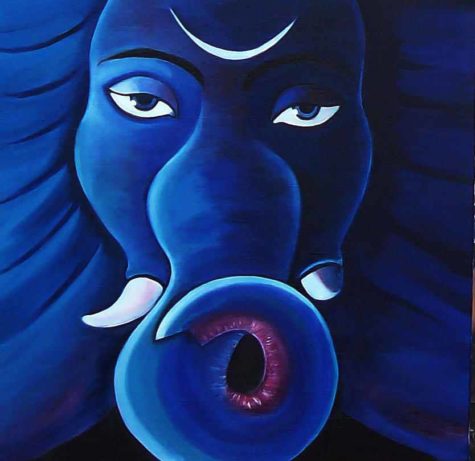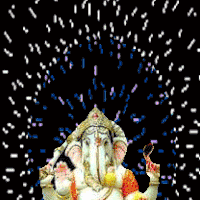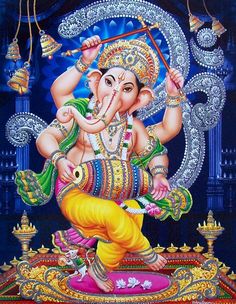About Ganesha
Why Ganesha Has An Elephant Head
There are of course many esoteric explanations regarding the elephant head. An elephant is strong, but always calm. It is one of the few animals conscious of itself and which even has funerary rituals. Despite its force, it is vegetarian.
Puranas offer many versions with regard to Ganesha’s birth and origins of his elephant head. In Shiva Purana it is told that he was created out of an ointment for washing(ubtan) which Parvati, the Divine Mother, took from her body. It is said that one day, as Parvati was preparing to take a bath, she became aware that the guardian of her apartments was missing. She then took a part of the soap from her body, molded it into the shape of a child and blew vital force, prana, onto it. She charged this child to be her guardian and instructed him not to allow anyone to enter the palace.
The child-guard respected his mother’s words and sat outside, with the scepter in his hand. Exactly then, Shiva chose to visit his beloved wife, Parvati, and he came to the palace. Because the little guard prevented him from entering, Shiva got angry and threatened the boy but he was unflinching and only with the support of demons and gods together he could be defeated. Shiva became so furious, that he cut off the boy’s head with his trident.
When the Divine Mother discovered what had happened she was very sad and asked Shiva to bring him back to life. Shiva started to search for the first child sleeping orientated towards the north in order to cut his head off and place on the lifeless body. It was night and all the mothers were sleeping holding the children tight in their arms and therefore Shiva could not take the head of any child. However he saw an elephant calf sleeping alongside its mother, back to back, and decided to take advantage of this opportunity. Therefore he took the head of the elephant calf and joined it to the guardian child’s body, thus bringing him back to life.
Shiva named the boy Ganapati, leader of his troops and decided that every man should adore him before conducting any major action.
Another version states that Ganesha was born as a favor granted to Parvati, following her prayers to Vishnu. The Divine Mother then invited all gods and demigods to come visit her child. They came looking to the child full of concern – all of them except for Shani (Saturn), who looked into the ground because he had been cursed by his wife that any being that looked upon would be transformed into ashes.
The Divine Mother was convinced, however, that her baby could not be harmed by Shani’s eyes and despite the curse and she beseeched him again to look at the child and bless him. The moment that Shani looked at the baby, he head turned into ashes. Vishnu flew away riding Garuda (the god with an eagle’s head, his traditional vehicle), searching for a child in order to bring its head, according to Brahma’s indications. The head he found was that of an elephant calf.
There are many other stories from various ages (kalpas), regarding Ganesha’s birth but they all reveal the fact that he is a creation of the Divine Force, either Shiva or Shakti. Ganesha was created in order to guard the Divine Mother’s palace. So he is the only one that can allow us to get to Her.
Article taken from Yoga Magazine magazine, issue no. 23
When Prayers Don’t Work
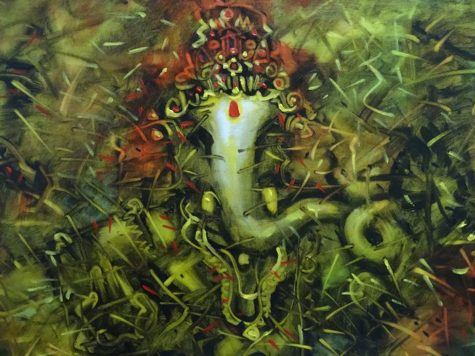
What does it mean when an obstacle is encountered despite our sincere supplication of Lord Ganesha?
It may mean that the time, the means, or the goal itself is not right for our karma and dharma. The architect presents his finished plans to the engineer. They are rejected for one technical reason or another. The executive presents a completed letter to the president. It is rejected as not being explicit enough in the third paragraph. The architect and the executive were equally sincere in presenting their work. The engineer and the president were performing their duty as well.
Lord Ganesha loves us. He is a loving God who guides, governs, and controls with speed and accuracy when the plan is perfect, deliberates long and rejects often when the plan needs revision.
Take the plan back into your mind. Search your own superconsciousness for the greater ideas, and revise your efforts with confidence. Seek for the right timing and proceed with confidence when you know the timing to be right.
“When the will rises and commands, even the Gods are willing to obey,” or to give immediate cooperation, to guide, and enhance our efforts. We must work our minds in close cooperation with the mind of Lord Ganesha, and then success is certain. Thus, this God is called Bhaktavighnavinasana, He who destroys the obstacles of the devotees.
From: Loving Ganesha
Who Is Ganesha?
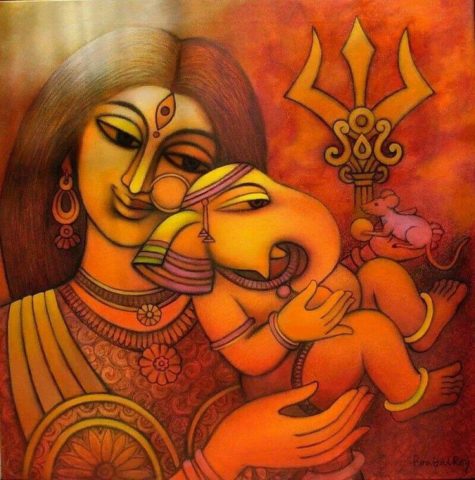
Ganesha is India’s cutest god. He has the head of an elephant on which is perched a dainty tiara, four pudgy hands joined to a sizeable belly with each hand holding its own symbolic object. One has a trishul, or a trident, the second, an ankush, or goad made from his very own broken tooth, the third hand elegantly holds a lotus and the fourth a rosary (which is sometimes replaced by modaks – his favourite sweet). His appetite for sweets is legendary and offerings of them are often left at his shrine.
Ganesha is famous not only for being a trickster and for his sense of humour, but equally for his wisdom. He is the son of Shiva (Destroyer in the Hindu Holy Trinity of Creator-Preserver-Destroyer) and Parvati (Shiva’s consort).
The chubby, gentle, wise, elephant-headed Ganesh, or Ganesha, is one of Hinduisms most popular deities. He is the remover of obstacles, the deity whom worshipers first acknowledge when they visit a temple. He is also patron of letters and of learning; he is the legendary scribe who, using his broken tusk, which he often holds, wrote down parts of the Mahabharata epic.
From Loving Ganesa
by Satguru Sivaya Subramuniyaswami
Ganesha – Lord of Beginnings
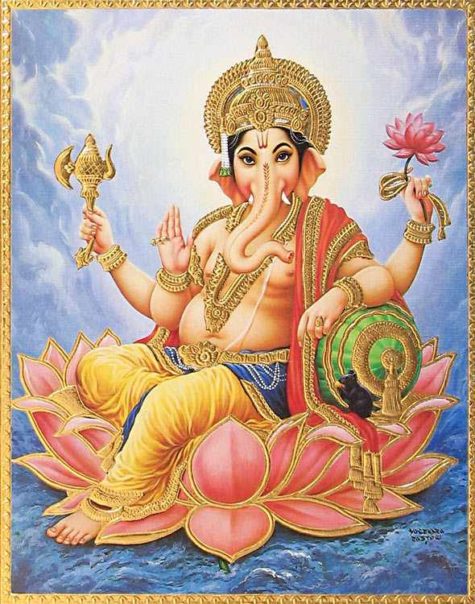
Elephant-headed Ganesha may be the most beloved deity of the modern Hindu pantheon; venerated by millions. He is invoked by Buddhists, Jains, and Neo-Pagans, too. He is benevolent and generous to all.
- Titles: Lord of New Beginnings; Lord of Obstacles; He Who Bestows Blessings
- Also known as: Ganapati
- Origin: India
- Color: White, Red, Pink
- Element: Water
- Numbers: 1, 3, 5
- Animals: Mouse, Snake
- Mount: Mouse
Lord of Beginnings, Ganesha’s blessings are sought before initiating any new enterprise. Ganesha is the Lord of Obstacles, removing but also creating them, sometimes from anger but sometimes just to attract further veneration. The flip-side of Ganesha is that he must be propitiated before new ventures lest he place obstacles in your path.
Ganesha bestows success, victory, prosperity, material comfort, romance, love, better six, and supernatural powers and skills to his devotees. He can block all these things, too, although he is unlikely to do so unless insulted and angered.
Ganesha is a generous, sympathetic spirit, quick to bestow favors. He is a trickster, but on behalf of his devotees and those he loves. Ganesha has a fast, volatile temper, but he calms down quickly too, and can be soothed and appeased. Just remember the old saying: “An elephant never forgets!”
- Ganesha is the first deity worshiped during Hindu rituals.
- His is the first image at the head of all processions.
- He is an indispensable component of all Hindu ceremonies except funeral rites.
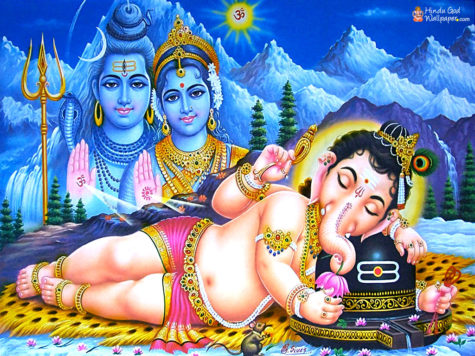
In The Beginning
Historical evidence indicates that Ganesha was known as early as 1200 BCE, however surviving depictions are rare before the fourth century CE. He was incorporated into the Hindu pantheon comparatively late, in approximately the 5th century.
Ganesha is believed to have begun his incarnation as a pre-Aryan elephant spirit venerated by jungle tribes. In addition to this other gifts, he was invoked for protection from elephant herds.
He was absorbed into the Hindu pantheon as the son of Shiva and Parvati. Various myths explain why Ganesha has an elephant head. In one, Parvati creates her son from the scrapings of her own skin. Ganesha was born while Shiva was away long-term practicing austerities.
Ganesha is extremely close to his mother. When she asked him to guard her privacy in the bath, he took up his position at the door. This was the moment Shiva returned. Father and son didn’t know each other. Shiva wished to see Parviti; Ganesha refused to let him pass. Shiva beheaded him. Parvati came to see the source of the commotion and was distraught. Now comprehending the situation, Shiva revived Ganesha but was forced to find a new head. The first to be had was an elephant’s.
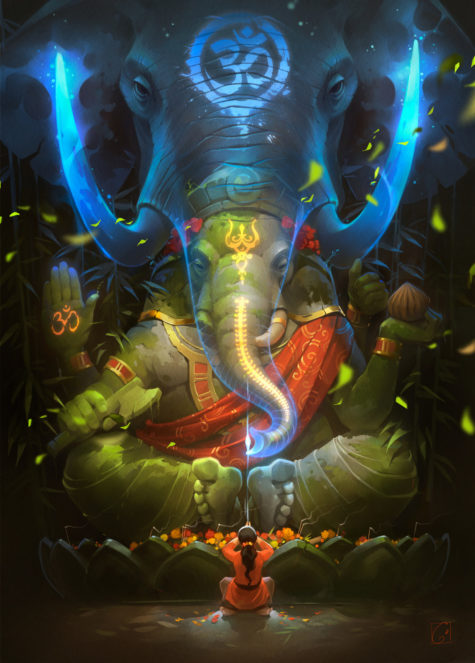
Petitioning Ganesha
Ganesha is lord of entrances, thresholds, and crossroads. Let him guard your door. It’s traditional to place his image above main entrance thresholds so that he is always encountered when entering.
Ganesha is happy to be venerated alongside other deities; however, never forget that he is the Lord of Beginnings. If you feed him, feed him first before any other spirits. There may be conflict if you venerate him alongside other spirits who also expect to be first served, for instance, Elegba.
- Ganesha heals physical, spiritual, and emotional ills.
- Ganesha has the power to liberate from the karma of past lives.
- He is invoked for children by the childless.
Petition him at a home altar or in a temple. Ganesha is the subject of a fertility ritual conducted at his temple in Madurai, India; allegedly if you bathe his image and circumambulate around it for forty-eight consecutive mornings, he will grant your wish for children.
Ganesha is a popular tantric deity, too. His trunk and single tusk are phallic symbols. Early Hindu texts suggest disapproval of Ganesha who was then associated with “orgiastic rituals.” He remains associated with Tantra among Buddhists. Ganesha communicates with devotees in dreams.
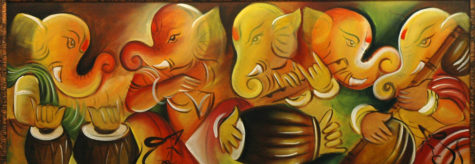
Favored People:
Ganesha will allegedly favor anyone who approaches him with a pure heart. He is the special patron of musicians who play the tabla and/or mridangam (percussion instruments), as well as authors, poets, and writers. In Thailand, Ganesha is considered patron of elephant trainers.
Manifestation:
Ganesha has an elephant’s head on a man’s pot-bellied body. He has one broken tusk. His skin usually has a rosy hue. His big ears signify his capacity to listen and hear. His forehead is marked with vermilion, indicating his tendency to involve himself in issues associated with women and his generosity toward female devotees.
Iconography:
There are countless images of Ganesha sitting, standing, dancing, or riding his mouse. Once you know what he looks like, he’s very recognizable.
Realm:
Ganesha’s home is a celestial realm called the Abode of Bliss (Svaanda Dhama). He lives in a marvelous palace surrounded by a forest of wish-fulfilling trees and an ocean of sugarcane juice.
Offerings:
Ganesha is easy to please, but he cannot be fooled. He will accept the most modest offerings but only if given with sincere intent and devotion. His favorite offering is said to be modaka, a type of sweet rice or wheat cake. Here’s a recipe: Recipe For Modaka. Allegedly the more modaka you give him, the more inclined his is to work on your behalf. Ganesha also accepts peanuts; fruits, especially bananas; sweets, candy, and sugarcane.
Source: The Encyclopedia of Spirits ~ Borrowed from The Powers That Be
